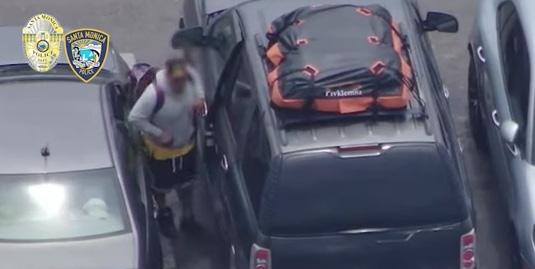




By Zach Armstrong
Santa Monica City Council commended a local unhoused resident for her heroic efforts in fighting off Jawann Garnett, who now faces a maximum sentence of life in state prison for his actions, from assaulting and possibly attempting to murder a teenage girl on Santa Monica Beach in late June.
On June 24 just before 10 a.m., Jenna Wilker was on Santa Monica beach when she witnessed Garnett attempting to strangle and rape a 17-year-old girl. She acted promptly to pull the perpetrator away from his victim, but was punched and bitten by the man before he continued attacking the teenage victim. Soon after, Garnett then began assaulting a woman in her 70s, pulling her into the ocean and holding her underwater.
Authorities arrived within minutes, halting Garnett’s rampage and taking
him into custody. The juvenile victim was transported to a local hospital with moderate injuries and later released. The other two victims, including Wilker, were treated on scene by lifeguards and fire department personnel.
Following the incident, the District Attorney charged Garnett with attempted murder and felony child abuse for the attack on the juvenile, assault with a deadly weapon likely to produce great bodily injury and assault with intent to commit rape for the attack on Wilker, and attempted murder and kidnapping for the assault on the elderly woman.
Garnett, who is currently homeless, has a criminal history in Los Angeles County that includes prior arrests for assault with intent to commit rape, false imprisonment, assault with a deadly weapon, and domestic violence.
City Council’s commendation for Wilker was made at its most recent meeting on July 9.
“Jenna’s actions demonstrated selflessness and courage under extreme circumstances, and prevented further harm to the victim and helped the SMPD apprehend the suspect. Jenna’s actions highlight the important role a bystander can play when they see someone in need of help.” Santa Monica Mayor Phil Brock stated on LinkedIn.
A GoFundMe page titled “Let’s House Our Hero, Jenna Wilker” aims to
A 4-year-old girl who was abducted from a Santa Monica restaurant was found safe within hours, authorities said.
The Santa Monica Police Department responded to a distress call around
12:11 p.m. Friday after the child was taken from a Panda Express on Lincoln Boulevard. The suspect, identified as 31-year-old Breanna Taylor Shields, was apprehended, and the child was rescued unharmed from the Holiday Motel, located less than half a mile from the restaurant.
The swift response followed a plea for help from the child’s grandmother. According to CBS News Los Angeles, more than 30 personnel, including officers, civilian workers, drone operators, and a K9 unit, canvassed the area.
Santa Monica police Lt. Erika

raise $15,000 in order for Wilker to find a residence and help pay for food and other bills. At the time of this writing, the campaign has raised over $4,600 across 123 donations.
On July 1, Wilker posted an update to the GoFundMe that stated “Please keep this going and get me into a place I don’t know how much more of being out here
I can take.” Two days later, she posted another update that said “Don’t let this slow down we are so close to getting me into a place it is crazy. Please share, I really can’t do this anymore.”
The GoFundMe can be found at https://www.gofundme.com/f/letshouse-our-hero-jenna-wilker.

Aklufi detailed the extensive search operation in an interview with ABC7, stating, “There were at least 30 of our department personnel out searching for her.”
Officers located the child and suspect nearly 30 minutes after the 911 call. Shields was arrested on suspicion of kidnapping, a felony charge punishable by up to 11 years in prison. Her bail is set at $100,000, and she is scheduled to appear in court Tuesday, as reported by The Los Angeles Times.
Santa Monica College has been recognized by MovieMaker magazine as one of the 30 Best Film Schools in the U.S. and Canada. This accolade places SMC alongside prestigious institutions like AFI Conservatory, Columbia
University School of the Arts, and UCLA.
This recognition follows SMC’s inclusion in MovieMaker’s 2022 lists, which featured the college among the Top 40 in the U.S. and Canada, as well as the Top 12 in the U.S. West and Northwest. The annual list honors schools that excel in preparing students for various facets of moviemaking. SMC is noted for being an affordable option near the entertainment industry’s epicenter.
“Santa Monica College offers an accessible, affordable film education at a fraction of the price of a fouryear university,” said Tim Molloy, MovieMaker’s editor-in-chief. He praised Salvador Carrasco, head of SMC’s film production program, for ensuring that students gain practical experience. Molloy emphasized Carrasco’s commitment to allowing students to “stand out based on their talent, attitude, hard work, and reliability — none of which has anything to do with socioeconomic background.”
Santa Monica College provides two-year programs in film studies and film production, enabling students to concentrate on either scholarly theory or hands-on filmmaking. The curriculum covers all aspects

of pre-production, production, and postproduction, with instruction from faculty actively working in the industry. This approach gives students real-world experience, bolstering their prospects for employment or further education.
“We are delighted to be ranked among the best film schools in North America,” said Salvador Carrasco. He highlighted the program’s focus on delivering highquality education without incurring long-term debt and the faculty’s dedication to professional mentorship.
Since its inception in 2010, SMC’s film program has produced 30 short
films and garnered numerous accolades, including awards at the Emerging Filmmaker Showcase at the Cannes Film Festival, the Russo Brothers Italian American Film Forum, and several international film festivals.
For more details on SMC’s film program, visit smc.edu/film or contact Salvador Carrasco at Carrasco_ Salvador@smc.edu.
The full list of MovieMaker’s 30 Best Film Schools in the U.S. and Canada for 2024 is available in their latest issue and online at moviemaker.com.
Jameelah Michl was sentenced to 35 years to life in state prison for the November 2023 shooting and killing of Michael Latt in his Mid-Wilshire home, Los Angeles County District Attorney George Gascón announced today.
“Today brings a measure of closure to a deeply painful chapter for Mr. Latt’s family, friends, and our entire community,” District Attorney Gascón said. “As a tireless advocate for social justice, Mr. Latt championed equality, justice, and equity in our criminal legal system. Mr. Latt’s ability to uplift the community left an indelible mark. His legacy will continue to inspire us to strive for a more just and inclusive society.”
Michl, 36, pleaded guilty on June 24 to one count of first-degree murder and
one count of first-degree burglary. She also admitted to using a firearm during the commission of the crime.
On November 27, 2023, Michl went to Latt’s residence in the 900 block of Alandele Avenue, targeting him due to his friendship with a woman she had been stalking. After forcing her way into the home, Michl shot and killed Latt with a semi-automatic handgun.
Latt founded the company Lead With Love, which sought to diversify the entertainment industry and support artists of color. This is Michael Latt’s biography on the company’s website:
“Michael Latt was an award-winning strategist, producer, and founder of Lead With Love who has developed and led nationwide campaigns, impact initiatives, and creative projects alongside influential artists, brands, and organizations like Common, Ryan Coogler, Netflix, Emerson Collective, Sundance Film Festival, DGA, Ava DuVernay’s ARRAY, Frieze, UCLA, Barry Jenkins and more. His purposedriven and innovative work has been recognized by the press and institutions like his alma mater, Chapman University,

where he was awarded Chapman’s annual Distinguished Alumni Award. Aligning his purpose and passion, Michael continues to dedicate his career to being of service, supporting influential women and artists of color,
and utilizing storytelling, art, and more to spark lasting change and bring hope, love, and inspiration to communities.” The case was investigated by the Los Angeles Police Department.

























The Santa Monica-Malibu Unified School District (SMMUSD) has announced its policy for providing nutritious meals to students every school day under the National School Lunch Program, School Breakfast Program, and Afterschool Snack Program for the 2024-25 school year.
Effective from July 1, 2024, through June 30, 2025, children are eligible for free or reduced-price meals if their household income is at or below federal guidelines. Households receiving benefits from CalFresh, CalWORKs, or the Food Distribution Program on Indian Reservations (FDPIR) will automatically qualify for free meals. Additionally, children who are foster, homeless, migrant, or runaway are eligible for free meals.
Households receiving an automatic qualification notification letter do not need to submit an application. If any child in such a household is not listed in the letter, families should contact school officials. Those who prefer not to receive free or reduced-price meals must also inform the school.
Applications for meal benefits will be distributed to households, and families
must submit one application for all children in the household to the Food & Nutrition Services office at 1717 4th St., Santa Monica, CA 90401. For a secure method to apply, households can use the online application at myschoolapps. com. Assistance is available by contacting Food & Nutrition Services at 310-450-8338, ext. 70228.
Households can submit applications at any time during the school year, especially if there are changes in income, household size, or if a household member begins receiving CalFresh, CalWORKs, or FDPIR. The information provided on the application will determine eligibility and may be verified by school officials. The last four digits of the Social Security number of any adult household member, or an indication that no Social Security number is available, is required if income is reported on the application.
Households receiving benefits from the Special Supplemental Nutrition Program for Women, Infants, and Children (WIC) may also be eligible for free or reduced-price meals by submitting an application. Foster children are automatically eligible for free meals and can be included as household members to help non-foster children qualify for meal benefits.
The eligibility status from the previous school year will carry over for up to 30 school days into the new school year. No reminders or expiration notices will be sent.
For disputes regarding the decision or results of verification, families can discuss the matter with school officials or request a fair hearing by contacting Richard Marchini, Director of Food and Nutrition Services, at 1717 4th Street, Santa Monica, CA 90401, or by calling 310-450-8338, ext. 70342.

By Kathryn Whitney Boole
I welcome that history seems to be a trend in films right now. Historical knowledge is vital in navigating the present, and there is not enough emphasis on it in our mass communications landscape. The Bikeriders tells the story of a motorcycle club in the nascent stages of that phenomenon. The inspiration was a 1967 photography book called The Bikeriders , by Danny Lyon, memorializing bikers of a Midwest club in the mid-1960’s -early 1970’s called The Outlaws. In the film, they are called The Vandals, with characters based on the real members. The Outlaws still exists and is one of the Big Four motorcycle clubs.
Lyons’ photo books are iconic. Lyon, now 82, was a budding photojournalist and a motorcycle enthusiast. He worked in the style of Photographic New Journalism, where the photographer becomes immersed in the subject, so it was fitting that one of his earliest projects was to embed himself in The Outlaws to record their adventures. He joined the club and was a member in 1966-67. Lyon became a legend of his craft. In
Rated R • 116 Minutes
Released June 21st, Still in Theatres, also online on Prime, Apple TV and other VOD platforms

1962, he had been inspired by a speaker he was photographing, John Lewis, who called on his audience to take part in the Civil Rights movement. From then


on, Lyon was present at almost every Civil Rights event, recording images in detail. John Lewis, of course, became a Civil Rights Icon and Congressman who served in the House for 16 terms until his death in 2020.
Writer/director Jeff Nichols had been intrigued for years about making a biker film set in the ‘60’s. When he brought up the idea to his friend, actor Michael Shannon in 2018, Shannon replied, “You’ve been talking about that damn film for so long. You’re never gonna make that film!” That was enough to set the wheels in motion. Nichols backed out of his commitment to direct A Quiet Place: Day One, to write and shoot The Bikeriders . He’s written an excellent script, not afraid to use sparse dialogue. The actors speak volumes through their movements and facial expressions, and the timing running through the narrative is fluid and balanced. A sense of angst picks up gradually throughout the film.


Nichols assembled a superb ensemble of actors who developed an intense chemistry that drives the story. Tom Hardy’s “Johnny” is the leader. Austin Butler plays one of the newer, more volatile members. Butler was in awe of Hardy’s work, and as he noted, “You never know when you meet your heroes if you’re going to get along.” Later, he noted, “Tom makes me laugh harder than almost anyone in the world.” The director and producers were floored when Hardy did his first scene in character. Nichols also noted that Butler’s presence started to “change the way people behave.” There is a scene of Butler lifting his
head from a pool table early in the film that eerily reflects one of Lyons’ photos. Jodi Comer, who plays “Kathy,” nails her role. Although she is British, Comer is from Liverpool from a workingclass family. Before her success as an actress, she was a checker at the Tesco supermarket and worked in a bar. With no traditional acting training, Comer is that rarity who can instinctively pull a character out of her own experience. Nichols added two great monologues for Shannon, who plays “Zipco.” In one scene, Shannon begins as a comedian and gradually slips over that thin line between comedy and tragedy flawlessly. Nichols realized that a line that came directly from Lyons’ book “was really building out the psychology of all these guys. They felt undesirable. They felt unwanted. And that’s why they all ended up together.”
The afternoon before I saw the film, I had visited the Dogtown Skateboarders exhibition in the Santa Monica Heritage Museum. One of the photos of this band of enthusiasts of speed, skill, and risk had suggested that their common bond was an aggression born of loneliness and an overflow of energy that linked them together as a band of brothers. These same forces drew the members of the motorcycle club together.
Kathryn Whitney Boole has spent most of her life in the entertainment industry, which has been the backdrop for remarkable adventures with extraordinary people. She is a Talent Manager with Studio Talent Group in Santa Monica. kboole@gmail.com
By Zach Armstrong
The Santa Monica Police department was able to locate and arrest a car burglar over Fourth of July weekend thanks to a drone; a tool which the City says increases officers’ ability to halt such incidents.
On July 6, as a bustling crowd filled
the beach along with the Pier and surrounding parking lots, the pilot of a Santa Monica Police drone began surveying the mass of people. As he flew over Lot 1 North, the pilot noticed a wandering male suspect approaching an unattended vehicle. After pulling out some tools, the man was seen punching open the driver side door’s lock before climbing into the vehicle. The suspect spent approximately two minutes inside the vehicle.
While the suspect was still inside, the drone pilot alerted officers of the situation. As authorities arrived on scene, the suspect was using the same tactics to break into a truck near the initial vehicle. As the drone was still aloft the parking lot, the pilot guided officers to the burglar’s location where he was found in possession of various stolen items.
The man was taken into custody for vehicle burglary along with multiple
L.A.-based nursery Rolling Greens has opened its fourth location in Santa Monica, marking its first store on the West Side.
The new store, located at 2537 Lincoln Blvd., is a transformation of an abandoned car wash into a vibrant garden space, offering indoor and outdoor plants, gardening supplies, containers, signature arrangements, home goods, and gifts.
Its retail locations in Culver City, Beverly Grove, and Studio City are popular among interior designers, industry experts, and plant enthusiasts.
Founders and owners Laurie Resnick

and Greg Salmeri were joined by Santa Monica Mayor Phil Brock to cut a green velvet ribbon at the grand opening. “We are thrilled to bring Rolling Greens to Santa Monica and offer this beautiful community a unique space to connect with nature,” Resnick said.
The grand opening weekend on July 13 and 14 featured a celebration with the local community and small business vendors.
“We’ve always believed in celebrating the diverse neighborhoods of Los Angeles and bringing people together,” Salmeri said. “Our Santa Monica location is a testament to our commitment to the community and bringing beauty into people’s lives.”

theft-related crimes.
“The DFR program incorporates a sworn officer pilot who flies the drone from a launch site on the roof of the Public Safety Facility. The officer monitors our radio channels and can listen to 911 calls as they come into dispatch.” as stated in a post by the City of Santa Monica. “The drone can be airborne almost immediately and has the advantages of being able to take the shortest route to calls and providing an overwatch for additional officers

arriving on the ground. Once on-scene, the pilot can provide updates, check for suspects fleeing and give a direction of travel, and guide in responding officers. All of this significantly increases our chances of successfully and safely ending dangerous incidents.”
Footage of the event can be seen at https://www.youtube.com/ watch?v=JneCzWup-L0&t=7s.


Last week’s S.M.a,r,t, article (https:// smmirror.com/2024/07/sm-a-r-t-columnfood-water-and-energy-part-1-of-3/) talked about the seismic risks to the City from getting its three survival essentials, food, water, and energy shut down by the inevitable large earthquake. Specifically, we looked at the risk to our water supply from the San Andreas Fault, which can sever the two large long-distance canals that supply approximately 25% of our water demand. Energy cut-off has a similar risk profile, but fortunately, there is more we can do to protect our City if we plan for it now.
Unlike vulnerable imported water, renewable electrical energy sources (wind, solar, hydro, tidal, geothermal) are already widely distributed in the LA basin, as are power plants of non-renewable energy sources (coal, oil, natural gas nuclear). The largest nearest renewable daytime power source are the thousands of existing city-wide rooftop photovoltaic and hot water solar collectors. These solar collectors reliably provide daytime power regardless of the price of oil, gas or what SCE charges. Just like our City’s cost of water, which is doubling over a five-year period, fossil fuel costs fluctuate widely which you can see daily at the gas pump.
While the cost of power for homes and business does not fluctuate as wildly like the market-manipulated volatility of automobile gasoline, it is inexorably upward because fossil fuels get exhausted by human extraction faster than new economical sources can be found. Coal mines get played out, oil is available only at deeper ocean depths or in hotter deserts (or farther arctic distances) than can be economically pumped out, and uranium for nuclear energy is only found in a few specific places. And, as expected, these rising nonrenewable energy costs disproportionally impact the poorest members of society.
So as global human energy needs increase, the sources of non-renewable energy, with their numerous advantages and dangers, first get stressed, then get extracted more efficiently, but finally get exhausted when the extraction costs exceed the value of that energy. There is some indication that we are currently reaching peak oil, after which oil production will decline, but its cost will of course, continue to climb. The crushing price pressure on fossil fuel will only increase because the cost of renewable power sources per kilowatt is now falling faster than the cost of gas, oil, and nuclearsupplied power.
There is another big distinction between

the renewables and nonrenewables. The former are generally “cleaner” than the latter. For example, the boom in US natural gas production from fracking has come at the permanent cost of hundreds polluted local water systems. Offshore oil platforms blow up (Deepwater Horizon), polluting miles of ocean. Burning coal blankets states downwind with acid rain and mercury, which has measurable negative health effects on humans and animals. Finally, nuclear plants regularly explode (Three Mile Island, Chernobyl, Fukushima, etc.) and also have spent fuel storage problems essentially lasting forever.
Renewables are not pollution-free, of course. The extraction of rare metals needed for solar collectors and batteries disturbs ecosystems and exploits workers like all mining activities do, while massive windmills kill thousands of migratory birds. However, in the overall balance, renewable energy sources are cleaner (have fewer secondary effects) than nonrenewable energy sources. The wide distribution of clean, renewable power sources increases seismic survival and also increases (by pollution reduction) the longevity of individual residents.
Variability of most renewable power sources
But what significantly separates the renewable from the nonrenewable is that usually, renewables are more prone to both regular and irregular interruption: the sun does not shine all day, tides rise and fall twice a day, wind does not blow continuously, and rain needed for hydropower (and food) varies seasonally. So humans have developed, through the millennia, hundreds of clever ways of ensuring a steady supply from variable sources. We have refrigerators to keep our food until our next trip to the grocery store. We build barns and silos to carry our food through the winter when it does not grow. We build reservoirs, dams,
and aqueducts to stabilize the seasonal variability of water. Finally, we use batteries to store power for later use when it has been previously generated from many sources, some of which are variable (solar, wind, etc) and some of which may be more steadily available (natural gas, oil, etc.).
The grid is not ready.
So, while renewable energy sources are cheaper, cleaner, and potentially more stable in an earthquake than fossil fuels, we are exposed by an incredibly vulnerable power grid. For example currently, your typical rooftop photovoltaic system is not designed, nor required, to be able to continuously operate if SCE does not provide your system power. For a variety of safety technical reasons, it shuts down automatically as soon as SCE’s power cuts off. And as previously discussed the San Andreas fault system crosses vulnerable transmission lines that connect us to the vast fields of solar collectors and windmills located in the deserts east and north of us. So, while we have abundant nearby and more distant sources of clean power, we may not be able to access them in a seismic emergency.
Finally, even if skyscrapers or any tall building could figure out how to generate enough power for their local needs from solar collectors, etc., they would soon lose that advantage as soon as a shading skyscraper was built next door. Unfortunately, we do not, at this time, have City codes in place to protect the solar rights of our neighbors, which is the most important step to a sustainable and resilient (able to withstand emergency interruptions) City. Why would anyone bear the expensive cost of building or retrofitting a solar collector system on their building if a neighbor could, at any time, render their system unproductive by shading it with a taller building? In this
manner, by not having solar access codes in place, the City is giving up its most direct path to a regular supply of daytime power, which will last as long as the sun shines. The shading power of unrestricted skyscrapers disincentivizes the entire City from converting to local solar power. Our City, with its proposed skyscraper binge, is giving up its best chance to become energy-independent and survivable in the next inevitable seismic event.
Next week’s article will discuss other challenges the City faces on its path to energy independence and survivability.
By Mario Fonda-Bonardi AIA
S.M.a.r.t Santa Monica Architects for a Responsible Tomorrow
Thane Roberts, Architect, Mario Fonda-Bonardi AIA, Robert H. Taylor AIA, Architect, Dan Jansenson, Architect & Building and Fire-Life Safety Commission, Samuel Tolkin Architect & Planning Commissioner, Michael Jolly, AIR-CRE Marie Standing. Jack Hillbrand AIA
For previous articles, see www. santamonicaarch.wordpress.com/writing




